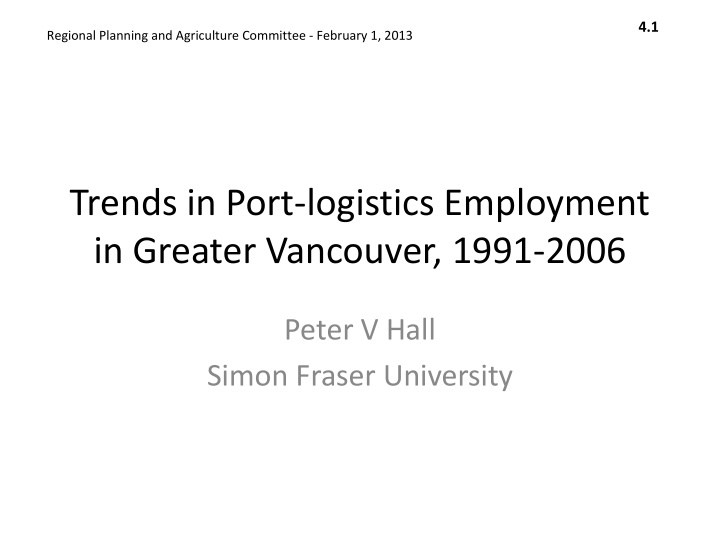



4.1 Regional Planning and Agriculture Committee - February 1, 2013 Trends in Port-logistics Employment in Greater Vancouver, 1991-2006 Peter V Hall Simon Fraser University
Vancouver ports’ 20 year container growth 3,000,000 10.0% 9.0% 2,500,000 8.0% 7.0% 2,000,000 6.0% 1,500,000 5.0% 4.0% 1,000,000 3.0% 2.0% 500,000 1.0% - 0.0% Vancouver Total TEU Vancouver share Linear (Vancouver share)
Port-logistics employment in Metro Vancouver declined slightly and changed a lot between 1991 and 2006 1991 2006 12000 10000 8000 6000 4000 2000 0 Rail Water Truck Warehouse FTA
Summary: employment and relative wages in port-logistics sub-sectors, 1991-2006 Employment Wages relative to growth: all other sectors: Canada Vancouver Canada Vancouver Rail Declined Declined Above average Above average Rose well above Water Declined Declined Above average average Truck Grew Flat Below average Below average Fell to below Warehouse Grew Grew Below average average Rose to above FTA Grew Grew At average average
The bottom line • Lots of port activity growth… ≠ Lots of employment growth = Lots of change in employment mix and locations • Overall employment in the sector declined slightly between 1991 and 2006: • Relative decline in Water, Rail [and Truck] • Relative growth in FTA and Warehouse • A sector of (mostly) good jobs: • Truck, Rail: no relative earnings differences • Water, FTA: relatively better in earnings in greater Vancouver • Warehouse: downward convergence • Significant change in sub-regional locations: • Decline in core, growth in south and east • Social geography of the sector is shifting
TRANSPORT SERVICES PORT NATIONAL IMPORTERS TRANSFER TO RAIL IMPORT LOCAL / LOCAL REGIONAL TRUCKING DISTRIBUTION PRODUCER EXPORT HANDLING EXPORT
TRANSPORT SERVICES PORT IMPORT IMPORT TRANSLOADING NATIONAL IMPORTERS CONTAINER LOCAL STORAGE TRUCKING PRODUCER EXPORT EXPORT STUFFING
Some principles for regional planning • The port’s relationship with the region extends beyond the waterfront • What we see today did not happen overnight • The port-logistics industry is a dynamic network: • Economies of scale and productivity in water and rail • Expansion of warehousing (transloading and stuffing) • Elaboration of intra-regional connectivity (aka. trucking) • Emergence of advanced services in FTA • Conventional port impact studies do not capture these dynamics well
Recommend
More recommend